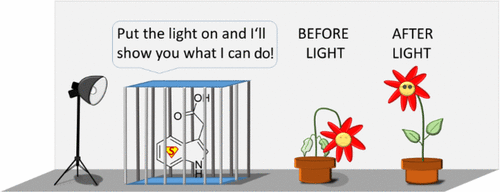当前位置:
X-MOL 学术
›
J. Agric. Food Chem.
›
论文详情
Our official English website, www.x-mol.net, welcomes your feedback! (Note: you will need to create a separate account there.)
Caged Phytohormones: From Chemical Inactivation to Controlled Physiological Response
Journal of Agricultural and Food Chemistry ( IF 6.1 ) Pub Date : 2021-10-05 , DOI: 10.1021/acs.jafc.1c02018 Noemi Hemelíková 1 , Asta Žukauskaitė 2 , Tomáš Pospíšil 2 , Miroslav Strnad 1 , Karel Doležal 2 , Václav Mik 3
Journal of Agricultural and Food Chemistry ( IF 6.1 ) Pub Date : 2021-10-05 , DOI: 10.1021/acs.jafc.1c02018 Noemi Hemelíková 1 , Asta Žukauskaitė 2 , Tomáš Pospíšil 2 , Miroslav Strnad 1 , Karel Doležal 2 , Václav Mik 3
Affiliation

|
Plant hormones, also called phytohormones, are small signaling molecules regulating a wide range of growth and developmental processes. These unique compounds respond to both external (light, temperature, water, nutrition, or pathogen attack) and internal factors (e.g., age) and mediate signal transduction leading to gene expression with the aim of allowing plants to adapt to constantly changing environmental conditions. Within the regulation of biological processes, individual groups of phytohormones act mostly through a web of interconnected responses rather than linear pathways, making elucidation of their mode of action in living organisms quite challenging. To further progress with our knowledge, the development of novel tools for phytohormone research is required. Although plenty of small molecules targeting phytohormone metabolic or signaling pathways (agonists, antagonists, and inhibitors) and labeled or tagged (fluorescently, isotopically, or biotinylated) compounds have been produced, the control over them in vivo is lost at the time of their administration. Caged compounds, on the other hand, represent a new approach to the development of small organic substances for phytohormone research. The term “caged compounds” refers to light-sensitive probes with latent biological activity, where the active molecule can be freed using a light beam in a highly spatio/temporal-, amplitude-, or frequency-defined manner. This review summarizes the up-to-date development in the field of caged plant hormones. Research progress is arranged in chronological order for each phytohormone regardless of the cage compound formulation and bacterial/plant/animal cell applications. Several known drawbacks and possible directions for future research are highlighted.
中文翻译:

笼养植物激素:从化学失活到受控生理反应
植物激素,也称为植物激素,是调节范围广泛的生长和发育过程的小信号分子。这些独特的化合物对外部(光、温度、水、营养或病原体攻击)和内部因素(例如,年龄)并介导导致基因表达的信号转导,目的是让植物适应不断变化的环境条件。在生物过程的调节中,单个植物激素组主要通过相互关联的反应网络而不是线性途径起作用,这使得阐明它们在生物体中的作用方式非常具有挑战性。为了进一步提高我们的知识水平,需要开发用于植物激素研究的新工具。尽管已经产生了大量针对植物激素代谢或信号通路(激动剂、拮抗剂和抑制剂)和标记或标记(荧光、同位素或生物素化)化合物的小分子,但在体内对它们的控制在其管理时丢失。另一方面,笼状化合物代表了一种开发用于植物激素研究的小有机物质的新方法。术语“笼状化合物”是指具有潜在生物活性的光敏探针,其中可以使用光束以高度空间/时间、幅度或频率定义的方式释放活性分子。这篇综述总结了笼养植物激素领域的最新发展。每种植物激素的研究进展按时间顺序排列,无论笼式化合物配方和细菌/植物/动物细胞应用如何。强调了几个已知的缺点和未来研究的可能方向。
更新日期:2021-10-20
中文翻译:

笼养植物激素:从化学失活到受控生理反应
植物激素,也称为植物激素,是调节范围广泛的生长和发育过程的小信号分子。这些独特的化合物对外部(光、温度、水、营养或病原体攻击)和内部因素(例如,年龄)并介导导致基因表达的信号转导,目的是让植物适应不断变化的环境条件。在生物过程的调节中,单个植物激素组主要通过相互关联的反应网络而不是线性途径起作用,这使得阐明它们在生物体中的作用方式非常具有挑战性。为了进一步提高我们的知识水平,需要开发用于植物激素研究的新工具。尽管已经产生了大量针对植物激素代谢或信号通路(激动剂、拮抗剂和抑制剂)和标记或标记(荧光、同位素或生物素化)化合物的小分子,但在体内对它们的控制在其管理时丢失。另一方面,笼状化合物代表了一种开发用于植物激素研究的小有机物质的新方法。术语“笼状化合物”是指具有潜在生物活性的光敏探针,其中可以使用光束以高度空间/时间、幅度或频率定义的方式释放活性分子。这篇综述总结了笼养植物激素领域的最新发展。每种植物激素的研究进展按时间顺序排列,无论笼式化合物配方和细菌/植物/动物细胞应用如何。强调了几个已知的缺点和未来研究的可能方向。



























 京公网安备 11010802027423号
京公网安备 11010802027423号